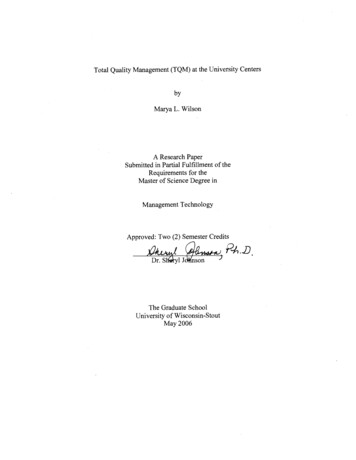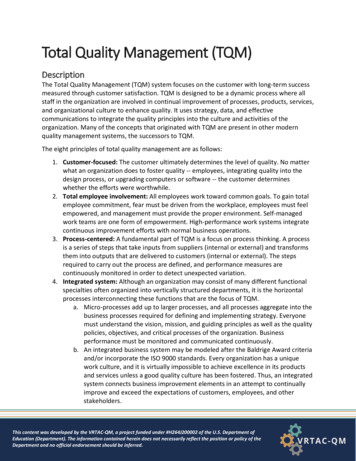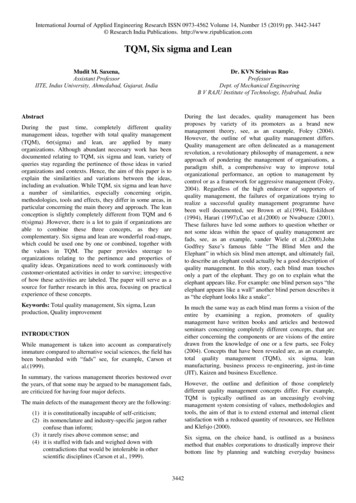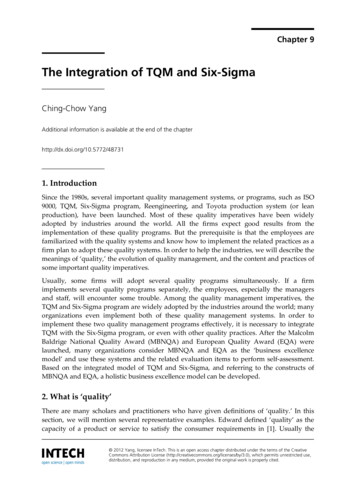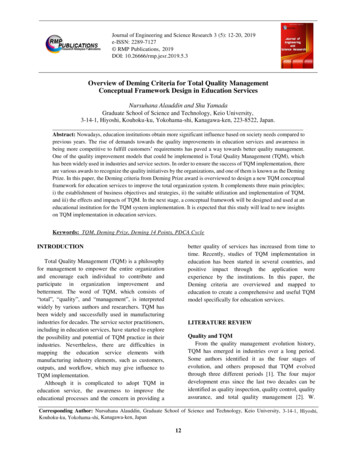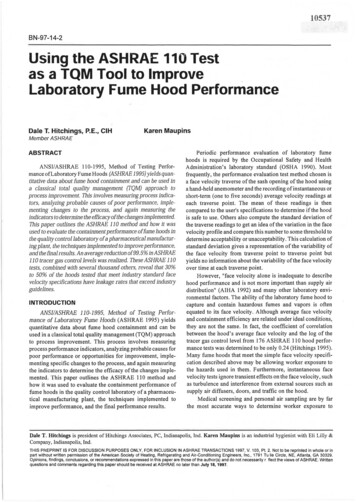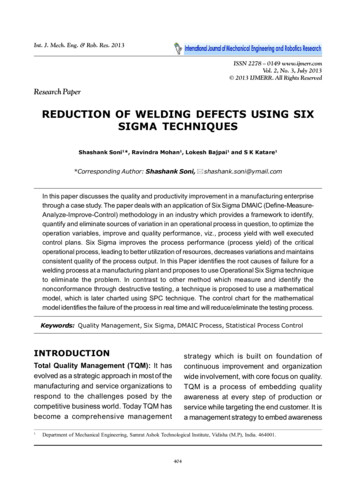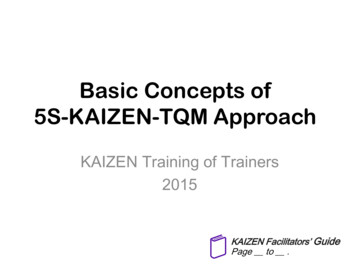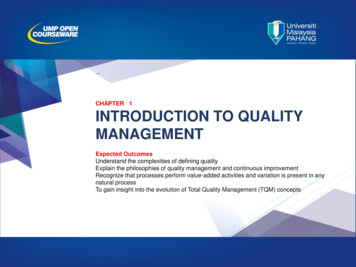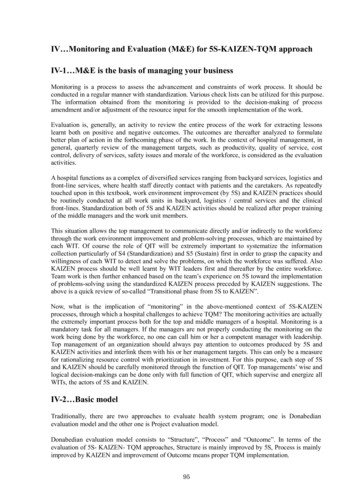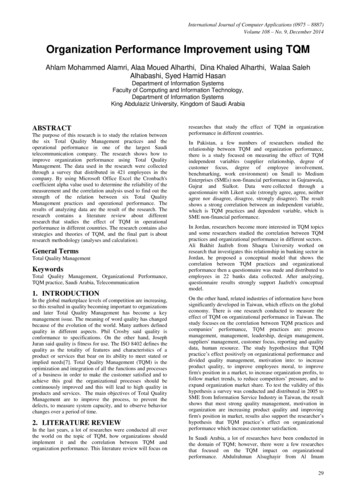
Transcription
International Journal of Computer Applications (0975 – 8887)Volume 108 – No. 9, December 2014Organization Performance Improvement using TQMAhlam Mohammed Alamri, Alaa Moued Alharthi, Dina Khaled Alharthi, Walaa SalehAlhabashi, Syed Hamid HasanDepartment of Information SystemsFaculty of Computing and Information Technology,Department of Information SystemsKing Abdulaziz University, Kingdom of Saudi ArabiaABSTRACTThe purpose of this research is to study the relation betweenthe six Total Quality Management practices and theoperational performance in one of the largest Sauditelecommunication company. The research shows how toimprove organization performance using Total QualityManagement. The data used in the research were collectedthrough a survey that distributed in 421 employees in thecompany. By using Microsoft Office Excel the Cronbach'scoefficient alpha value used to determine the reliability of themeasurement and the correlation analysis used to find out thestrength of the relation between six Total QualityManagement practices and operational performance. Theresults of analyzing data are the result of the research. Theresearch contains a literature review about differentresearch that studies the effect of TQM in operationalperformance in different countries. The research contains alsostrategies and theories of TQM, and the final part is aboutresearch methodology (analyses and calculation).General TermsTotal Quality ManagementKeywordsTotal Quality Management, Organizational Performance,TQM practice, Saudi Arabia, Telecommunication1. INTRODUCTIONIn the global marketplace levels of competition are increasing,so this resulted in quality becoming important to organizationsand later Total Quality Management has become a keymanagement issue. The meaning of word quality has changedbecause of the evolution of the world. Many authors definedquality in different aspects. Phil Crosby said quality isconformance to specifications. On the other hand, JosephJuran said quality is fitness for use. The ISO 8402 defines thequality as the totality of features and characteristics of aproduct or services that bear on its ability to meet stated orimplied needs[7]. Total Quality Management (TQM) is theoptimization and integration of all the functions and processesof a business in order to make the customer satisfied and toachieve this goal the organizational processes should becontinuously improved and this will lead to high quality inproducts and services. The main objectives of Total QualityManagement are to improve the process, to prevent thedefects, to measure system capacity, and to observe behaviorchanges over a period of time.2. LITERATURE REVIEWIn the last years, a lot of researches were conducted all overthe world on the topic of TQM, how organizations shouldimplement it and the correlation between TQM andorganization performance. This literature review will focus onresearches that study the effect of TQM in organizationperformance in different countries.In Pakistan, a few numbers of researchers studied therelationship between TQM and organization performance,there is a study focused on measuring the effect of TQMindependent variables (supplier relationship, degree ofcustomer focus, degree of employee involvement,benchmarking, work environment) on Small to MediumEnterprises (SMEs) non-financial performance in Gujranwala,Gujrat and Sialkot. Data were collected through aquestionnaire with Likert scale (strongly agree, agree, neitheragree nor disagree, disagree, strongly disagree). The resultshows a strong correlation between an independent variable,which is TQM practices and dependent variable, which isSME non-financial performance.In Jordan, researchers become more interested in TQM topicsand some researchers studied the correlation between TQMpractices and organizational performance in different sectors.Ali Bakhit Jaafreh from Shaqra University worked onresearch that investigates this relationship in banking sector inJordan, he proposed a conceptual model that shows thecorrelation between TQM practices and organizationalperformance then a questionnaire was made and distributed toemployees in 22 banks data collected. After analyzing,questionnaire results strongly support Jaafreh's conceptualmodel.On the other hand, related industries of information have beensignificantly developed in Taiwan, which effects on the globaleconomy. There is one research conducted to measure theeffect of TQM on organizational performance in Taiwan. Thestudy focuses on the correlation between TQM practices andcompanies’ performance, TQM practices are: processmanagement, management, leadership, design management,suppliers' management, customer focus, reporting and qualitydata, human resource. The study hypothesizes that TQMpractice’s effect positively on organizational performance anddivided quality management, motivation into: to increaseproduct quality, to improve employees moral, to improvefirm's position in a market, to increase organization profits, tofollow market trends, to reduce competitors’ pressure, and toexpand organization market share. To test the validity of thishypothesis a survey was conducted and distributed in 2005 toSME from Information Service Industry in Taiwan, the resultshows that most strong quality management, motivation inorganization are increasing product quality and improvingfirm's position in market, results also support the researcher’shypothesis that TQM practice’s effect on organizationalperformance which increase customer satisfaction.In Saudi Arabia, a lot of researches have been conducted inthe domain of TQM; however, there were a few researchesthat focused on the TQM impact on organizationalperformance. Abdulrahman Alsughayir from Al Imam29
International Journal of Computer Applications (0975 – 8887)Volume 108 – No. 9, December 2014Muhammad bin Saud Islamic University studied therelationship between TQM and employee job satisfaction inparticular, researcher focus on private firm in Saudi Arabia asa sample for his study, then a survey was distributed in 2013to 350 employees in a large Saudi Telecom company with a74.5% response rate.The result shows that TQM has a strong impact on employeesatisfaction which increases work quality and individualproductivity.3. THE TOTAL QUALITYMANAGEMENT (TQM) STRATEGYTo be adopted any organization would be applied the qualityapproach, it should be understood strategic total managementas a proactive situation rather than as just technique, or highlevel guarantee products and services. The strategic totalquality adoption as one of organization part are ministration practices by adopting innovation strategies,also it is important to develop organizational strategic culture.The following strategies help organizations to develop theTQM process:1.TQM Element Approach2.Guru Approach3.Organization Model Approach4.Japanese Total Quality Approach5.Award Criteria ApproachDeming Prize winning and use this experience to developlong range main plan for in-house use.3.5 5th strategy: Award Criteria ApproachThis approach, focus on the criteria of any quality awards fororganization like, European Quality Award and, DemingPrize, to identify improvement areas. So the TQMimplementation will focus on meeting specific award criteria.Despite, there are some people argue that this is not anappropriate use of award criteria, there are some organizationsapply this approach and success to improvements.4. THEORY OF TOTAL QUALITYMANAGEMENTThe techniques and tools of TQM based on theories tomanage the process that concentrate on quality. Many expertshave helped to formalize different viewpoints in qualitymanagement. From the most popular theories:1.Deming Theory.2.Joseph Juran Theory.3.Crosby Theory.Theory of total quality management can be summarized asfollows[9]:Table1: Summery of TQM TheoriesTheoryNameDemingTheory Principles1. System of profound knowledge: System Knowledge: understandingof the organization's processes andsystems, and how they work toachieve the organization aim. Variation Knowledge:understanding of the causes ofalteration. Knowledge, Theory:understanding the knowledge thatcan benefit the organization. Psychology Knowledge:understanding peoples’ attitudes,and how they interact and work.Below there are a brief about each strategy and itsexplanation.3.1 1st strategy: TQM Element ApproachEarly in 1980s the companies used his method, they learn andtry to implement little parts of TQM. The TQM elementapproach takes all main business operations andorganizational units to use the tools of TQM to make betterimprovements. Quality function deployment, quality circles,and statistical process control are examples of thisapproach[12].3.2 2nd strategy: Guru ApproachThis approach used technique on one of the leading qualitythinkers as guide against which determines where theorganization has weakness and make appropriate changing tofix that weakness.3.3 3rd strategy: Organization ModelApproachBy using this method the Malcolm Baldrige National receivedthe Quality Award late of 80s, in this approach, there isindividuals or team who visits the organization and takes theleadership role in TQM and determine their businessprocess and reason of success then integrate these ideas withtheir own ideas to improve current organizational modeladapted for their required specific organization.2. Deming’s 14 points of total qualitymanagement[13].3. The Plan-Do-Check-Act (PDCA)cycle[13].Juran3.4 4th strategy: Japanese Total QualityApproachFlorida Power and Light used this approach to implementTQM and to compete for and win the Deming Prize. By usingJapanese total quality, organization would examine thetechnique of detailed implements and the strategy that used byCrosbyQuality trilogy is (Joseph M. Juran; A.Blanton Godfrey,1999):1.Quality Planning: understandingcustomer needs and developingproducts that met their needs.2.Quality Control: measuring andevaluating performance.3.Quality Improvement: achievingquality by focusing on long term goals.1.Define quality as a compatibility torequirements.2.Produce quality by prevention.30
International Journal of Computer Applications (0975 – 8887)Volume 108 – No. 9, December 20143.The performance standard of qualityis Zero Defects. Part 4 questions about Employee relations Part 5 questions about Supplier quality management4.Measuring the quality by the price ofnonconformance. Part 6 questions about Process management quality Part 7 questions focus on company operationalperformance5. TOTAL QUALITY MANAGEMENTAND ORGANIZATIONALPERFORMANCESince TQM is an important factor in organizationsdevelopment in terms of decreasing product price, increasingprofits, increasing product quality, minimizing productioncosts, gain competitive advantage over other organizationsand increasing employees and managers’ satisfactions,researchers in Saudi Arabia become more interested in TQMissues and studies, also some organizations have alreadystarted implementing TQM in its departments. One ofimportant studies in TQM topic investigates the correlationbetween TQM and organizational performance, which thispaper will focus on:5.1 Framework ModelIn order to study the relation between the operationalperformance and the TQM practices within thetelecommunication company, a theoretical TQM model weredeveloped to focus how this relation correlated and thedirection between the pairs. The figure below shows the sixTQM practice in the top and operational performance in thebottom and the relation between them:Questionnaire distributed to a sample of 421 employees in theSaudi Telecommunication Company, using a Likert scale foranswers to score from 1 to 5, where 1 means stronglydisagree, 2 means disagree, 3 means neither agree nordisagree, 4 means agree and 5 means strongly agree. Thediscussion about each factor of sex practices in the companyas follows:5.2.1 LeadershipLeadership is an important goal for any organization, and thetelecommunication company targeted in this study is a leaderin different fields. It's a leader company on employees'satisfaction by using a yammer social network, which is a freespace for internal communications between employees,managers and decision makers in the company, this spaceallows them to share their feelings, concerns, problems andsuggestions. The company also motivates their employees toparticipate in competitions with others to share theirinnovative ideas related to technology, telecommunicationand advertising, then a voting campaign takes place and themost innovated idea gets a financing from the company tosupport it. On the other hand, the company plans to be led bytransforming completely from telecommunication provider toinformation communication technology service provider(ICT) in 2020, by establishing data centers cross SaudiArabia.5.2.2 Customer FocusInternational Organization for Standardization ISO 900014000 [15] emphasized that in order for the organizations tobe customer focus, they are supposed to focus on theircustomers by understanding the requirements of their currentand future customer, and should meet customer needs andstrive to exceed customer expectations. Focusing on thecustomer is one of the important objectives of quality[7].Customers are the most important factor and are a major keyin the telecommunication company that targeted in this studyby providing them with different services to serve and cover abig range of customers.5.2.3 Strategic PlanningFigure 1: Framework Model5.2 Research MethodologyThe study is a correlation (on field) study implemented on oneof the largest Telecommunication Company in Saudi Arabiaduring the period of 21st September 2014 till 2 November2014, and the company applies a quality management strategythat uses management practices as an input and companyperformance as an output. To find out how much TQM effecton organizational performance specific operationalperformance of the company, a questionnaire was conductedthat contain seven parts related to each quality managementpractice and operational performance: Part 1 questions about Leadership Part 2 questions about Customer focus Part 3 questions about Strategic planningStrategic planning is a process of accomplishing theestablished vision, mission and goals of the organization. Asillustrated by Juran that the strategic quality planning isdeveloping a procedure to achieve the organization longterm goals by determining customer needs and respond tothem by delivering the desired products or services[8]. In thisstudy, the telecommunication company has clearly determinedits vision, mission, objectives and values. It well defined longterm plan and a clear strategy to achieve growth and movefrom mobile telecom provider to a global player in ICT.5.2.4 Supplier Quality ManagementThe organization's ability to satisfy the interests of differentsuppliers is a key factor of the success of TQM. Supply chainmanagement in TQM "implies reducing and streamlining thesupplier base to facilitate managing supplier relationships,developing strategic alliances with suppliers, working withsuppliers to ensure that expectations are met, and involvingsuppliers early in the product development process to take31
International Journal of Computer Applications (0975 – 8887)Volume 108 – No. 9, December 2014advantage of their capabilities and expertise"[11]. Because thequality of input is directly related to the final product, therelationship between the organization and the supplier isimportant.5.2.5 Employee Relations"The concept of Total Quality Management emphasizescontinuous improvement and this requires participation ofevery individual in the company"[6]. Employee relations areimportant factors making TQM job successful. The way toencourage employees and making them responsible forquality decisions and improvements is sharing informationacross functional groups of the organization[14]. If therelationships between employees are good and strong this willlead to positive results on organizations.Thetelecommunication company in this study often has a shorterdecision making process, enabling a faster information flowand improved communication [14] between employees.5.2.6 Process Management QualityProcess management, quality mentioned as an effectiveprimary element of integrated quality efforts. Process refers toall resources used in production. TQM beliefs that the productquality starts from improving process quality direct orindirect. Building quality process in production to reduce thevariation of process is the main objective of processmanagement. By applying this the waste and rework costs ofresources will be decreased while quality of output will beincreased. The telecommunication company established asolid track of record by its strong management team. It makesa lot of smart systems to improve the quality managementprocess. For example, it implements a private cloud solutionto support its business service management. By applying thissystem, it allow the end users to access the cloud self-serviceportal and request services, the new service provisioning takesa 35 minute instead of weeks, it offers a high availability ofstaff for projects, it used enterprise change management tocontrol infrastructure resource. The service fulfillmentprovisioning has a fully unattended instead of several teams.In addition, the cloud services, catalog of the system appliesthe quality and standard for all services. It gives a strong andefficient, utilizing reporting in the cloud.6. CORRELATION COEFFICIENTCALCULATIONSData analyzed to calculate the correlation in two stages byusing Microsoft Office Excel to analyze the data. Aftercollecting the results of the survey, data inserted in MicrosoftExcel, then start analyzing the data as first stage and checkedit by applying Cronbach's Alpha to gauge its reliability. Insecond stage is applying the correlation analysis to assess thestrength of the relationship between factors.6.1 Reliability AnalysisBefore testing collected data, preliminary analysis appliedfirst to check for any violations in it. This study was appliedscale of Cronbach's coefficient alpha value which is the mostwidely used statistics to determine the reliability of themeasurement. The result of Cronbach's alpha for all factors isabove 0.68 which is acceptable range and means the datareliable for measuring parameters.Management (SQM), Process Management Quality (PMQ)and, Operational Performance (OP)Table2: Reliability test result by using Cronbach’s AlphaVariableNo. of itemsAlpha 30.9973SQM30.9987PMQ30.9957OP180.98016.3 Correlation AnalysisCorrelation provides answers to this study in looking therelations between TQM six practices and operationalperformance of data in a research. It also tells the direction ofthe relation between each factors and company performanceand the magnitude of it.The correlation coefficient value of performance and six TQMpractice variables results in the table below.Table3: correlation result between all varaiblesLCFSPL1CF0.638SP-0.539 0.306ER0.391 0.959 0.564EROPOP111SQM -0.711 -0.995 -0.209 -0.925PMQSQM PMQ11.000 0.649 -0.526 0.405 -0.72210.312 0.931 0.203 0.996 -0.891 0.3271To evaluate the results if the value is positive that means thevariables are correlated positively to each other which meansif a variable increased the other one will be increased. Onother side, if the value is negative that means the variables arenegatively correlated to each other which means if a variableincreased the other will be decreased. Also, if the value isgreater than 0.5 that means it is strongly correlated to eachother, but if it is less than 0.5 and more than 0 that means it isweakly correlated.From the result the correlation between performance theleadership, strategic planning and, process managementquality are positively correlated to the organizationoperational performance. In the same time the companyoperational performance was strongly correlated to thecustomer focus and, employee relations. There is a negativecorrelated between supplier quality management in thecompany and performance.See table below. The variables in the table are as following:Leadership (L), Customer Focus (CF), Strategic Planning(SP), Employee Relations (ER), Supplier Quality32
International Journal of Computer Applications (0975 – 8887)Volume 108 – No. 9, December 2014Table4: correlation result between performance and shipwith 1.000-7. CONCLUSIONThis research study the effect of using Total QualityManagement practices on the operational performance of anorganization through production performance improvement,employee morality and customer satisfaction. The relationwas tested in a Saudi telecommunication company. Inaddition, according to the result of the analyzed data, therewere a positive correlation between leadership, strategicplanning, and quality management process and theorganization performance. Moreover, it was stronglycorrelated with customer focus and, employee relations, butnegatively correlated with supplier quality management. Theresults that have been accessed are consistent with previousstudies in the literature review that there is a positive relationbetween the operational performance of organization and theTotal Quality Management practices. In future work, towardstudy the effect of TQM practices in the financialperformance of organization and the relation between them.8. ACKNOWLEDGEMENTThe authors also, acknowledge with thanks Department ofInformation Systems-Faculty of Computing and InformationTechnology and Science and Technology Unit, KingAbdulaziz University for extending all support and facilitiesin completing this paper.9. 80/0954412979767[5] Chin, S. O., Fang, C. L. & Yu, C. H., The Effects ofTotal Quality Management on Business Performance:Evidence from Taiwan Information-Related Industries.Retrieved from National Chung Cheng University,Department of Accounting and Information 007/research forum/Ou,%20Liu,%20Hung%20and%20Yen.pdf[6] Gunasekaran, A. (1999). Enablers of total qualitymanagement implementation in manufacturing: a casestudy. Total Quality Management, 10(7), 987–996.[7] ISO (2012). Quality Management Principles.[8] John F. Dix and H. Lee (2002). INTRODUCTION TOSTRATEGIC PLANNING. The Process Of StrategicPlanning, Article 1.[9] Jrgensen, K. B. & Nielsen, A. F. (2013). The effects ofTQM Critical Success Factors on OrganizationalPerformance. Retrieved November 1, 2014 from MSc.Finance & International Business Aarhus /pure.au.dk/portal/files/55321016/The effects of TQM Critical Success Factors on Organizational Performance.pdf[10] Malik, S. A, Iqbal, M. Z. & Yong, J. (2010). TQMPractices & Organizational Performance: Evidence FromPakistani SMEs. In International Journal of Engineering& Technology,10(4). Retrieved from COMSAT Instituteof Information Technology, Department of ManagementSciences Web site: 1] Sadikoglu, E. & Olcay, H. (2013). The Effects of TotalQuality Management Practices on Performance and theReasons of and the Barriers to TQM Practices in Turkey.In Advances in Decision Sciences,2014. RetrievedNovember 1, 2014 from Gebze Institute of Technology,School of Business Administration Web 05/#B39[1] Ahire, S., Golhar, D., & Waller, M. (1996). Developmentand Validation of TQM Implementation x.doi.org/10.1111/j.1540-5915.1996.tb00842.x[12] Singh, Kanwarpreet, and I.P.S. Ahuja. "Transfusion ofTotal Quality Management and Total ProductiveMaintenance: a literature review", International Journalof Technology Policy and Management, 2012[2] Anderson, J.C., Rungtusanatham, M., & Schroeder, R.G.(1994). A Theory of Quality Management Underlyingthe Deming Management Method. Academy OfManagement Review, 19(3), 472-509.[13] Wasage, Cha. "Measuring the Effectiveness of Six SigmaImplementation in Fortune 500 Companies: AnEmpirical Study", Proquest, 2014[3] Anderson, J.C., Rungtusanatham, M., Schroeder, R.G., &Devaraj, S. (1995). A Path Analytic Model of a Theoryof Quality Management Underlying the DemingManagement Method: Preliminary Empirical dx.doi.org/10.1111/j.1540-5915.1995.tb01444.x[4] Bilich, F. & Neto, A. A. (1997). Strategic total qualitymanagement. InTOTAL QUALITY MANAGEMENT,2.Retrieved from University of Kent, Department ofEconomicsWebsite:IJCATM : www.ijcaonline.org[14] K. B., & Nielsen, A. F. (2013). The effects of TQMCritical Success Factors on Organizational Performance.Aarhus University. Retrieved 8 21, 2014, fromhttp://pure.au.dk/portal/files/55321016/The effects of TQM Critical Success Facto[15] Xia, J. (2009). Factors Influencing Chinese Suppliers’Quality Performance: A Supplier Selection Model For(Smes) To Ensure Their Chinese Supplers’ Ability ToProvide Quality Products. Terre Haute, /technology/faculty/sinn/Xia%20Dissertation.pdf33
organization performance. This literature review will focus on researches that study the effect of TQM in organization performance in different countries. In Pakistan, a few numbers of researchers studied the relationship between TQM and organization performance, there is a study focused on measuring the effect of TQM
